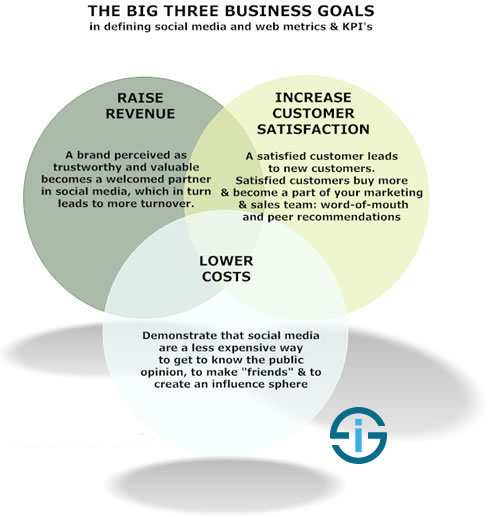
Jim Sterne is among many other things, Chairman of the Digital Analytics Association. In this interview, Jim shares his views on the role of social media marketing, obviously looking at analytics and metrics/ROI of social media as well.
Many marketers think about brand reputation, social media monitoring, community building, blogging and advertising when talking about social media. However, as always there is a very strong connection between social media marketing and other forms of marketing when we take the integrated marketing view that’s so important in a customer (experience) and optimization context. Social media marketing is also an umbrella term as are phenomena such as inbound marketing, content marketing, you name it. It’s the goals that matter, not the terminology.
Jim, how would you define social media?
Jim Sterne: Social media is an ecosystem of communication tools. They can be used to listen and to broadcast. Yes, the term ‘broadcast’ is frowned on in this case, but it applies. A marketer wants his or her message to go out far and wide and blogging, tweeting and discussion boards are all valuable when used in the right way. Yes, listening skills are critical and using what you hear to improve your SEO (search engine optimization) and your SEM (search engine marketing) is vital. But using these communications tools for seeding a messaging and then measuring the response is also very valuable, when done carefully.
Conversion is a factor of revenue
What is your advice to businesses to take their analytics beyond the basics and clickstream data, and focus on social KPI’s and ROI, especially now that many companies are introducing marketing ROI as a way to plan, forecast and approve marketing plans (yes, in social media marketing ROI matters too).
Jim Sterne: There are three ultimate business metrics: Revenue, Costs and Customer Satisfaction. Conversion is a factor of revenue. The question for each company to ask is which key performance indicators point the way toward improving these ultimate metrics for their particular business. If 10% more leads at a lead quality of B+ or better will result in a 15% increase in revenue, then you know how much you can afford to invest in which programs. KPI’s are the ‘dashboard’ to help you know if your goals are being met, if your campaigns are delivering as hoped or if there’s something rotten in Denmark.

In other words: to define the right KPIs (Key Performance Indicators), you should first know your business goals of course. However, then another issue arises: we know (or at least, should know) a lot about web analytics and KPI’s in many ‘traditional’ areas like websites, search, email, etc. but what about social media marketing where everyone is still talking about engagement, conversations, interaction, and so forth? How can you integrate all the old, slightly old, new and very new ways of marketing into a holistic view of the customer/prospect?
The seven steps in the customer life cycle
Jim has seven words for us: “Awareness – Opinion – Response – Engagement – Conversion – Retention – Advocacy” (remember good old reach, acquisition, conversion, retention and loyalty Jim and Matt Cutler introduced in 2000 in their paper “E-Metrics; Business Metrics For The New Economy” that you can still download on the website of Jim’s Target Marketing).
Jim Sterne: These seven steps apply along a timeline with each customer. Company functions should be assigned based on these areas rather than on specific technologies.
There should be technical services and expertise available to your marketing teams, but they should be customer focused and ask for technology help when needed.
The vendors: towards collaboration, integration and incorporation
What will the impact of all this be on the various vendors of analytics, monitoring and other customer intelligence solutions? How will the market evolve?
Jim Sterne: Everything will be integrated and everything will be in the cloud, and eventually we’ll end hunger and have world peace. Until then, companies like Radian6 and Webtrends will team up and form best-of-breed partnerships while companies like Omniture (note: acquired by Adobe last year), Unica and SAS will continue to grow their marketing automation systems to incorporate as much as possible.
Let’s hope we end hunger and have world peace, but what I take away from a business viewpoint (which is less important then world peace of course), is that we can expect a lot of announcements the coming months regarding vendors teaming up.
And I strongly agree that we will have to watch very closely what the vendors of web analytics, marketing automation and other platforms do. And, by the way, this goes for email marketing and thus ESPs too, if you ask me.
Customers will vote with their wallets
Is analyzing the digital footprints of the customer and serving/guiding them across their buying journey in an integrated way more than ever key? Especially in these times of an increasingly – physically – invisible customer where we’re moving from a focus on the selling process to the buying process.
Jim Sterne: The customer is more visible now than ever! We can see them by following, listening, measuring, etc. Yes, we should capture as much data as we can, and if we use it unwisely, customers will vote with their wallets and run away or vote with their legislation and shut us down. Yes, we should participate and set up dialogues and join the conversation. It is massively time consuming in comparison to dropping a milling postcards in the mail or sending out mass emails. However, those who invest and do it well will enjoy a serious competitive advantage.
If I had to resume this in a few sentences? It’s not the media or the tools that matter. Social media marketing is marketing. Companies should be where their customers are. It’s about the customer. About people. And about business: revenue, costs, customer satisfaction. Not number of followers or fans.
It’s always about that and always will be, social media or not.

